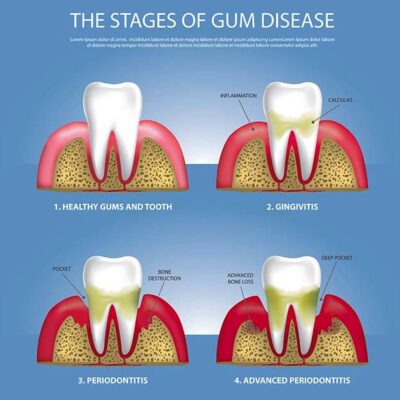Gum disease, also known as periodontal disease, is a serious oral health problem that results in chronic inflammation of the gums and eventual tooth loss. It affects nearly half of American adults and has been shown to have close links with other major health conditions. It is defined as jaw bone loss around teeth caused by plaque that hardens to form calculus, or tartar. If identified in its early stages, it is easily treated by your dentist or gum specialist. The disease often goes unnoticed due to not having symptoms until the moderate or severe stages.
There are various factors including oral hygiene habits, contributing health factors and genetics that can play a role in gum disease. The most effective way of preventing or identifying periodontal disease is by adopting good oral hygiene and by having routine dental exams.
How do you get gum disease?
It starts with gingivitis. Gingivitis is inflammation in the gums due to plaque and food sitting just below the gums. Plaque is that film you feel on your teeth if you haven’t brushed your teeth. It’s a combination of saliva, food, and bacteria. If you notice some bleeding of the gums when you brush or floss this is likely the first sign. Proper brushing and flossing can remove this plaque and gingivitis can resolve.
If plaque sits on the teeth and below the gums for too long, it hardens into tartar. This cannot be removed with brushing and flossing. With time, this causes constant inflammation in the gums, which may result in red, tender, bleeding gums. Eventually, deeper pockets begin to form between the gums and teeth, which starts the process of loss of supporting bone around the teeth. Unlike gingivitis which is reversible, bone loss around the teeth cannot be cured. Prevention of further bone loss can be managed, however. A proper diagnosis from the dentist can help identify the severity of bone loss, what is causing it, and how to proceed with treatment options.
What will happen if I am diagnosed with a periodontal disease?
A proper diagnosis starts with a routine dental exam. Beginning to moderate stages of periodontal disease may be treated in our office with a procedure known as “scaling and root planing”. This is a process that involves scaling all of the tartar off of the deeper surfaces of the teeth to allow for the gums to form a healthier attachment back to the tooth. This treatment is done with local anesthetic and requires 2-3 visits to complete and evaluate how your gums respond. From there, optimal homecare and a more frequent periodontal cleaning (periodontal maintenance) schedule will be discussed with Dr. Jimmy Lutz.
Do I need to see a gum specialist?
Depending on the severity of your condition, you may be referred to a gum specialist , or periodontist. We work closely with periodontists in Lafayette that can formulate a treatment plan that is best for you. Treatments vary according to the type of periodontal disease you have and how far it has progressed.
How can I find out if I have periodontal disease?
If it has been awhile since you’ve had a dental exam or suspect you may have gum disease, schedule an exam today at Downtown Dental to find out if you need periodontal treatment. Call or text 765.345.8284

